A very simple board to add 4K RAM to lower address space ($0400-$13F
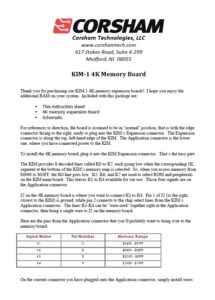 |
Manual KIM-1 4K RAM board |
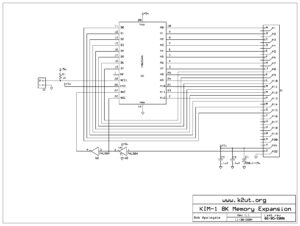 |
Schematic 4k RAM Board |
About small SBC systems
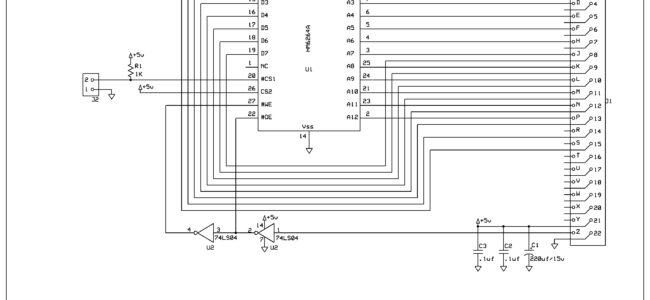
A very simple board to add 4K RAM to lower address space ($0400-$13F
 |
Manual KIM-1 4K RAM board |
 |
Schematic 4k RAM Board |

Bob Applegate used github repositories to archive and supplement some of his projects.
While this github archive is still up (August 2024), it may go away too.
So here dumps of the repositories. Some of the contents may also show up in the Corsham projects archive pages.
6502 Tiny BASIC
# 6502 Tiny BASIC
This is Bob Applegate’s (bob@corshamtech.com) spin of a Tiny BASIC interpreter for the 6502. It uses an IL approach, like proposed by Dr Dobb’s Journal in the first few issues. This is not fancy, it’s not bug free, and it’s not amazing by any means, but it was fun to write and decent enough to do fun stuff and run demos.
CTMon65
CTMon65 – 6502 monitor
Eagle Libraries
These are libraries used in Corsham Technologies LLC prodcuts (www.corshamtech.com).
# SS-50.lbr
This is for constructing SS-50 and SS-30 compatible boards. It includes both male and female Molex connectors. For constructing plug-in boards using a female connector my suggestion is to place the center of the library part 0.15″ above the bottom of the board.
# S-100.lbr
This is for constructing S-100 boards and is, for now, more of an experimental library rather than something that has any sort of polish about it. Feel free to use but don’t be too disappointed when it does not meet your expectations.
Kicad SS50
# KiCad SS-50 Library from Corsham Technologies, LLC
This is a free to use library that was developed during our creation of
various SS-30/SS-50 boards.
KIM Monitor
# KIM-Monitor
KIM monitor as modified for the Corsham Tech KIM Clone board.
Music Board master
# SS-30 Music Board
This is a rough recreation of the Newtech Computer Systems model 68 music board. No atttempt
was made to make it look exactly like the original, but it is 100% compatible and uses the
same components as the original.
SD Drive
SD Drive Arduino firmware
SD Shield Tester
The SD Shield Tester is a program to test the Corsham Technologies SD Card System shield. This is primarily a manufacturing tool but can be used for general testing. It’s not very useful, but if you suspect an SD Card shield is malfunctioning, this is a way to test it.
xDbg
# xDbg
xDbg is a 65C02 debugger meant to compliment the Corsham Technologies xKIM monitor
xKiM
# xKIM
xKIM is an extended monitor for KIM computer systems. Commonly used in Corsham Technologies KIM-1 add-on boards.
It is a 6502 based monitor which has basic tools as well as some additional commands for working
with the Corsham Tech SD Card system.
xSBUG
xSBUG
This is the Corsham Technologies version of the SWTBUG SBUG monitor for the 6809. It is close to the original but has support for the Corsham Tech SD Card System (emulates disk drives).
xSWTBUG
xSWTBUG
This is a modified version of the SWTPC monitor SWTBUG for use on their 6800 based SS-50 systems. It has additions for the Corsham Tech SD card subsystem and other minor improvements.

As you can read below in the screenshot of the last post on Corsham’s website below, Bob has left us. I will miss him, a dear friend with whom I exchanged many emails about the KIM-1.
To honor his legacy I have collected on these pages everything available, from his former website, Github repositories and information I have received from Bob, enhanced with photos of Corsham products I have bought over the years.
I have decided not to replicate his website. Instead the structure is about all of his projects, current and past, with on each page all information available to me about the product, enhanced with available material from outside.
Note that I do not have more information. I do not have the PCB designs. I do not sell any Corsham product. All I have is here is what Bob once published.
If you are interested in the SWTPC range, have a look here: original Corsham boards and more 6800/6809 products at Peripheraltech.
Links
The Corsham Technology website used to live at https://www.corshamtech.com
Bob’s private website is still up (August 2024) at https://k2ut.org/
The Github repositories are also still up at https://github.com/CorshamTech
The forum at groups.io is here: https://groups.io/g/CorshamTech/

Pages you find here:


The last message on the Corshamtech website with the sad news about Bob.

Bob Applegate at his desk
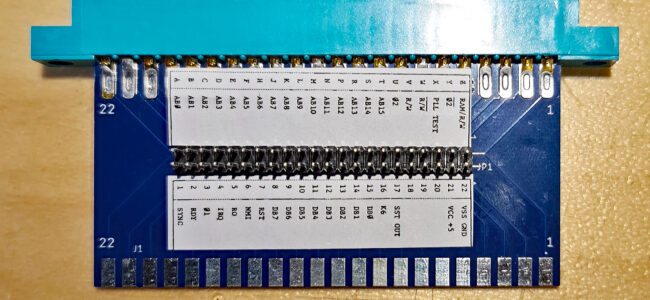
Bus extender
A handy bus extender from Retrospy. I glued labels from the KIM-1 manual on it, the PCB labels are wrong. PCB edges pads could be a little longer.
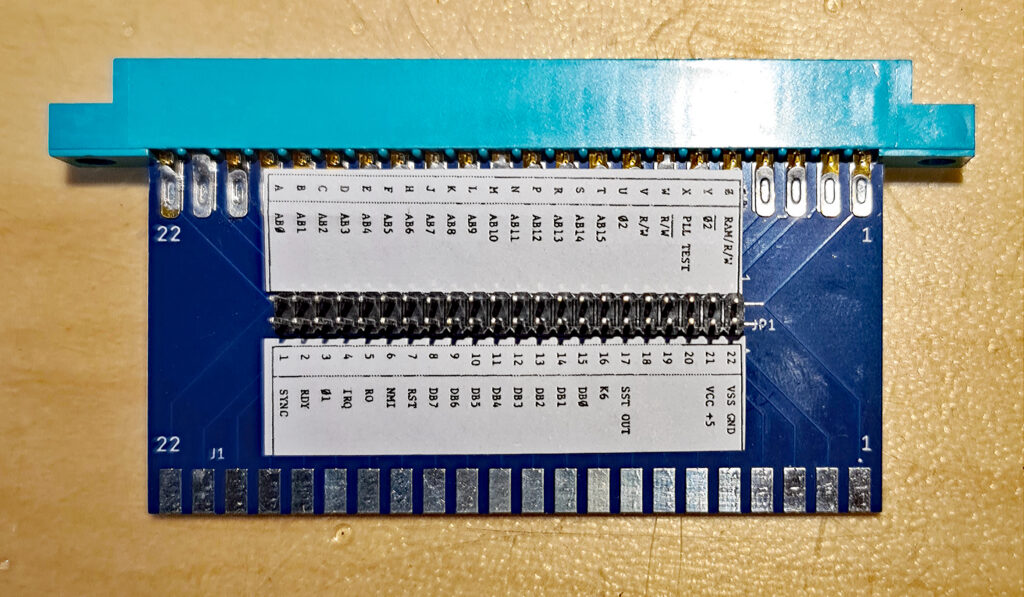
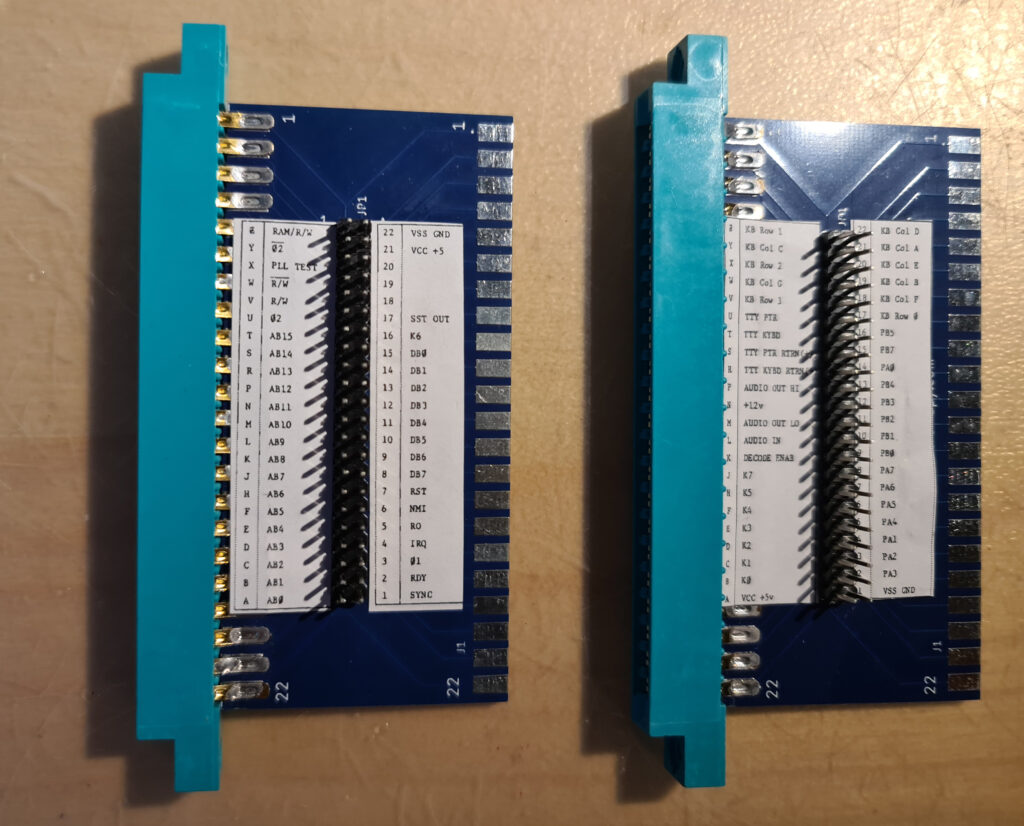
RetroSpy Technologies produces a range of retro (Vintage) hardware products that are of interest for the KIM-1/SYM-1/AIM 65 owner. Also the PAL-1 user may benefit from the products!
Retrospy is inspired by the Corsham Technologies products and since Bob Applegate is no more among us, produces similar/inspired products.
I bought several products from RetroSpy.
KIM-1 RAM/ROM Board
MOS 6530 Replacement for the KIM-1 SBC
PAL-1 Motherboard Expansion Kit
Bus extender
Other interesting KIM-1/AIM 65/SYM- related boards on the Retrospy shop:
AIM 65 I/O board
SYM-1 I/O board
SYM-1 SymDos I/O board
SYM-1/AIM-65 RAM/ROM board
KIM-1 I/O board
2532 to 2764 EPROM adapter
SD Card Storage System (like the Corsham one)
I should have bought he KIM I/O card also, for the 1541 connector, next time!
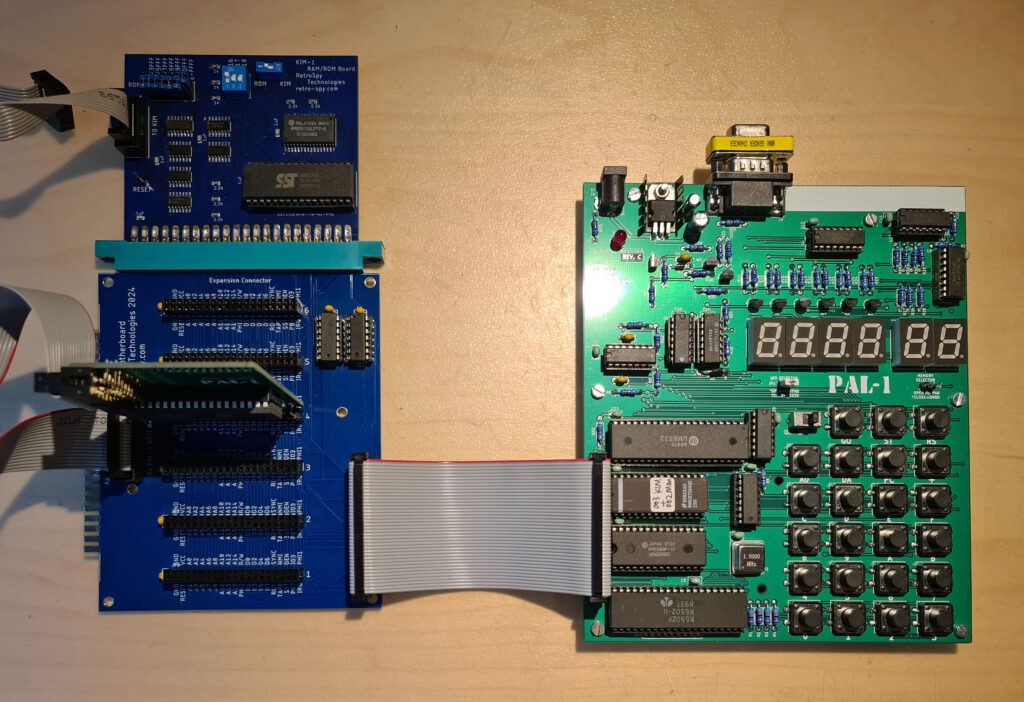
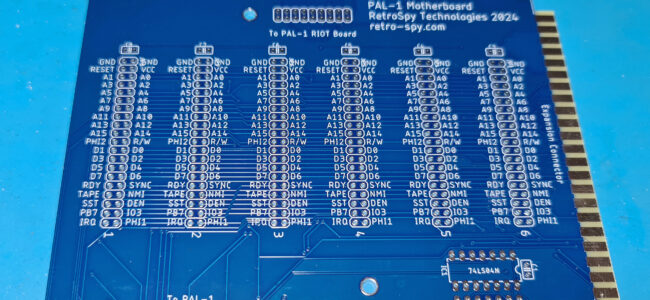
The 6530-002 AND 6530-003 RRIOT (RAM ROM I/O Timer) are the heart of the KIM-1. The mask programmed ROM contains the KIM-1 software, very early and smart 6502 code.
These ICs are not available for a long time now, and that prevents repairing a KIM-1 with a faulty 6530.
Ruud Baltissen designed many years ago a KIM-1 clone, where the 6530 was replaced with the nearly identical, no ROM, 6532. This led to the MicroKIM, the PAL-1, the Corsham clone.
Also boards to replace the 6530 with a 6532, a small EPROM and some glue logic were made.
Bob Applegate and Eduardo Casino did this with PCBs and through hole components. Rather large boards that work fine.
Retrospy Technology used SMD to shrink the PCB to to a bit oversized 6530. Samll enough to fit on a KIM-1 in an IC socket.
Description from the Retrospy store:
Drop in replacement for impossible to find and replace MOS/Commodore KIM-1 specific MOS 6530 integrated circuit.
Jumpers on the board switch between 6530-002 and -003.
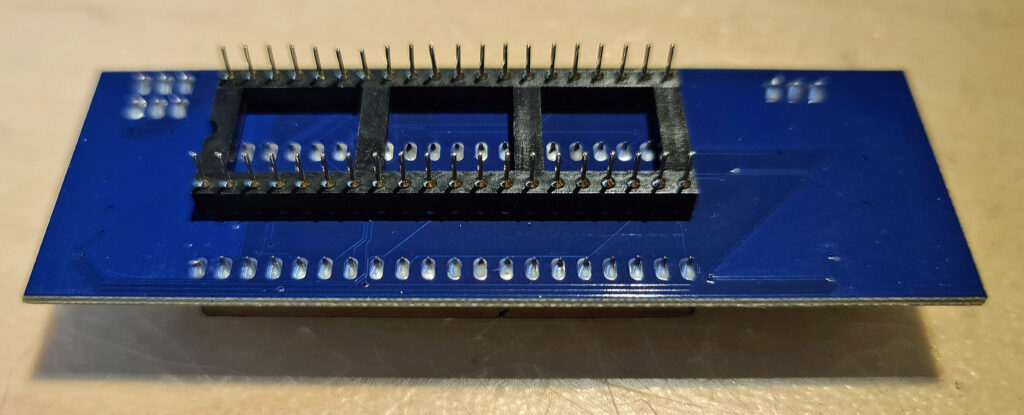
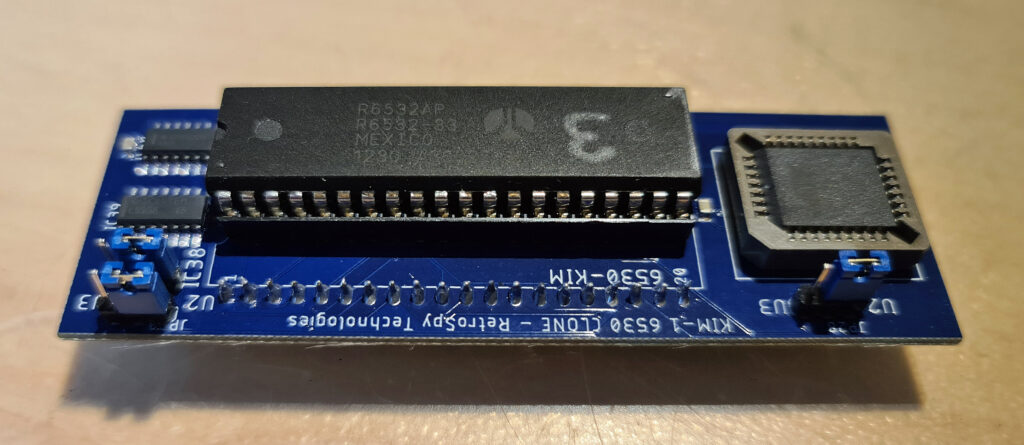
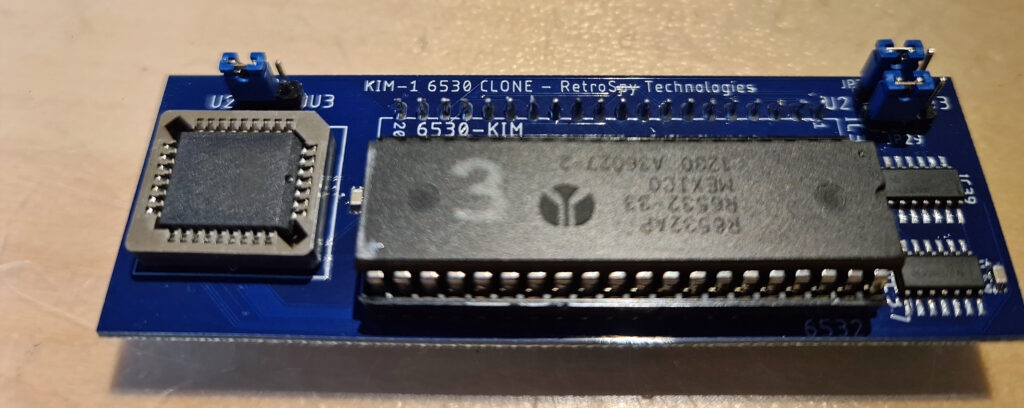
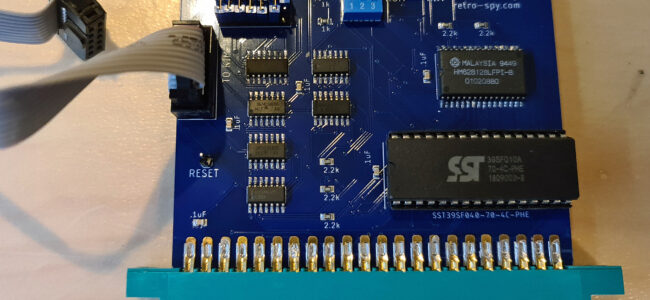
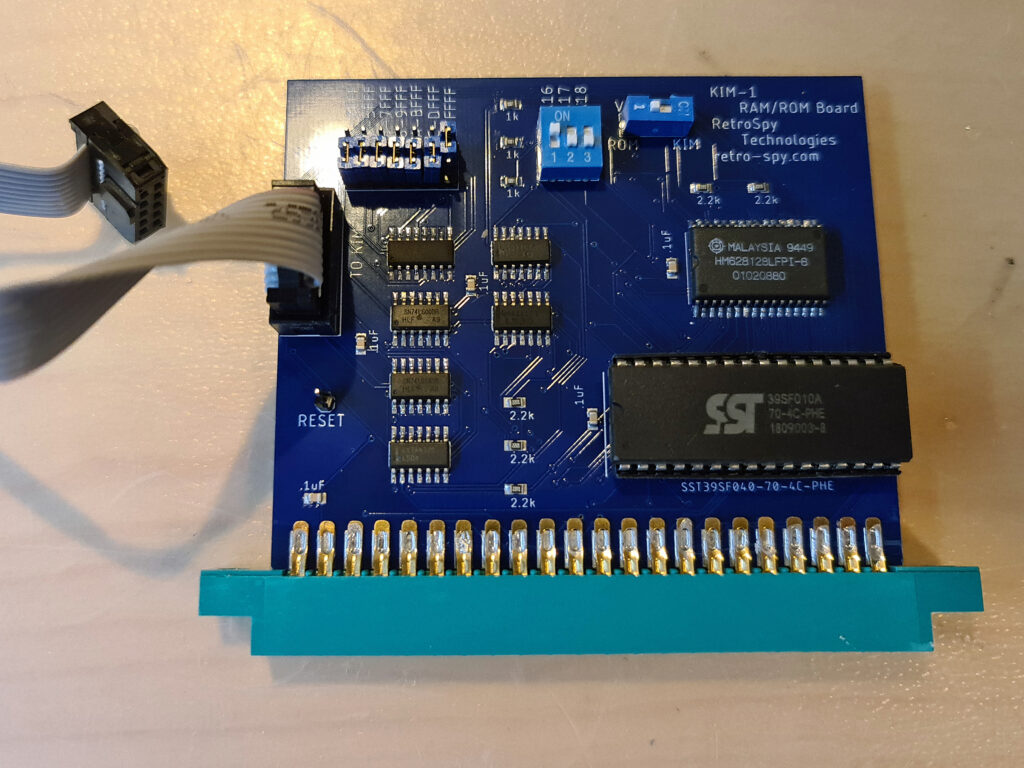
I bought this assembled and ready to run board from Retrospy Technologies.
SMD technology, so small and of high quality.
Description from the Retrospy store:
The KIM-1 RAM/ROM board is a custom board than expands the memory of the KIM-1 single board computer.
Features
Inspiration taken from a design by Bob Applegate of Corsham Technologies, LLC.
This board can be added to any KIM-1 system, but the easiest way to add it is with the Retrospy or Corsham I/O Board. This board comes with a ribbon cable that plugs right into the I/O Board with no mess. By default the DIP switches are set so your KIM will have 5K of RAM from $0000 to $13FF and from $2000 to $DFFF. The extended monitor is from $E000 to $FFFF.
For PAL-1 users with the PAL-1 Motherboard Expansion Kit
– the RAM RAM between 0x0400 and 0x13FF is already on the PAL-1 board, leave that open.
– The usual PAL-1 configuration has ROM at A000-B000, the PAL-1 ROMs are made for that location
– Without the KIM-1 I/O card, just put a Dupont male-female wire between Pin 10 of the “To KIM” connector to Decode Enable of a motherboard connector or K of a KIM-1 Connector expander.
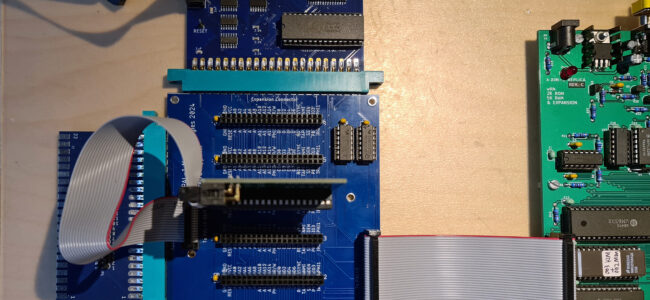

The PAL-1 connected to the PAL-1 Motherboard Expansion kit
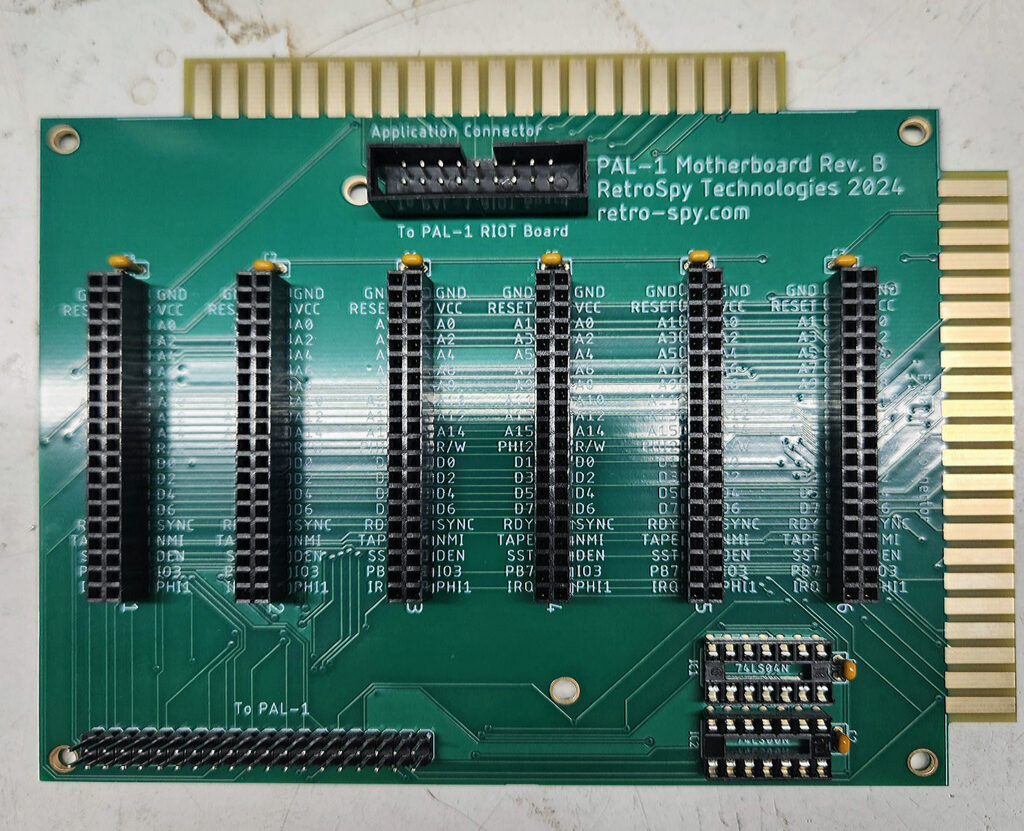
Revison B with larger edge fingers
Description from the Retrospy store:
With this motherboard, you can connect up to 6 expansion boards to your PAL-1 at the same time. The motherboard also provides the Application and Expansion connectors found on the original KIM-1, enabling the use of original KIM-1 expansion boards.
NOTE: To do anything worthwhile with the Application connector you will need the PAL-1 2nd RIOT Expansion Kit.
Not all signals are routed to the Application and Expansion connectors because the PAL-1 doesn’t provide them, so there is no guarantee every expansion board will work. However, Corsham Technologies’ and RetroSpy Technologies KIM-1 I/O and KIM-1 RAM/ROM boards have been tested and are compatible.
Available signals on the Application connector:
+5V
GND
PA0-7 (with installed PAL-1 2nd RIOT Expansion Kit)
PB0-7 (with installed PAL-1 2nd RIOT Expansion Kit)
DECODE ENAB
Missing are KB Row 0-3, KB Col A-G, TTY KYBD + RTRN, TTY PTR + RTNR, AUDIO Out (lo, hi), AUDIO IN, +12V, K0-K5, K7
Available signals on the Expansion connector:
+5V
GND
A0-A15
D0-D7
SYNC
RDY
IRQ
NMI
RST
SST OUT
PHI2
R/W
/R/W
/PHI2
RAM/R/W
Missing signals are: K6, SST, RO (pin 38 of the 6502), Phi1 (pin 3 of the 6502), PLL Test. On Reb B Phi1 is also available.
The signals /R/W, /Phi2 and RAM R/W are regenerated with two logic IC’s, the (reverse engineered) circuit is show below. The circuit could be a bit simpler, 3/4 of the 74LS00 would suffice.
Add KIM-1 RAM/ROM boards
Any KIM-1 RAM/ROM board can be connected to the Expansion connector. The Retrospy KIM-1 RAM/ROM is an excellent one.
For the PAL-1 only the Decode Enable line has to be added. For exammple with one wire Dupont male-female cable, from a motherboard connector. Any RAM in the region 0-1FFF is already available on the PAL-1 itself and should not be enabled on a RAM expansion. And therefore no need for signals K1-K4, the chip select lines for that region.
This version of the expansion kit has some minor points to improve (2.2 will be a next version the designer told me):
– add Phi1, not used often but is available on the PAL-1 connector
– enlarge the PCB edge pads with some mm’s, KIM-1 boards detach now to easy
– the two logic IC’s can easily be replaced with one 74LS00, only one NAND port and two inverters are required
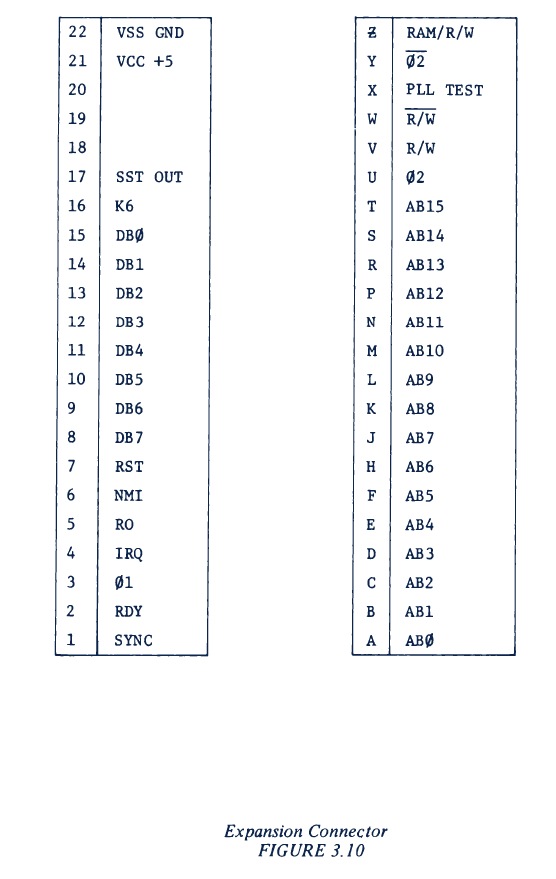
KIM-1 Expansion connector
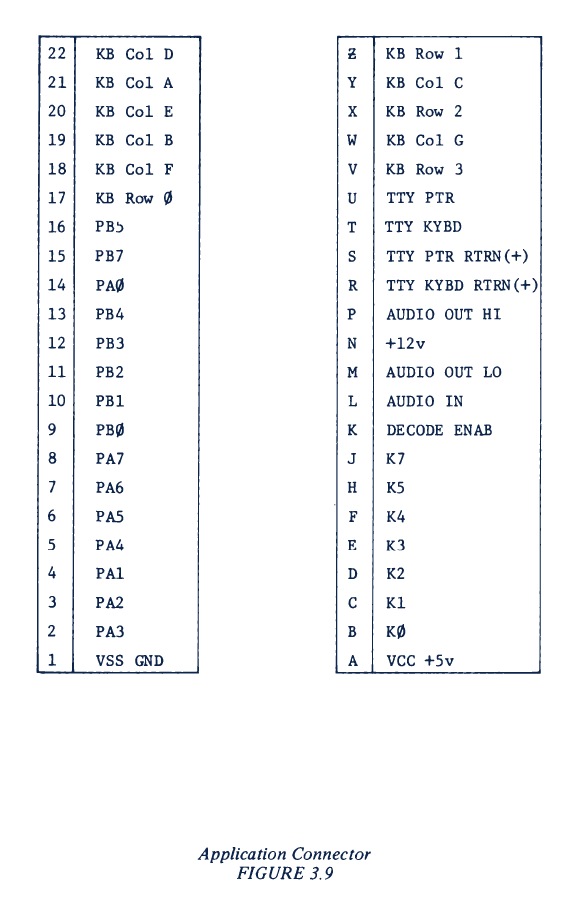
KIM-1 Application connector
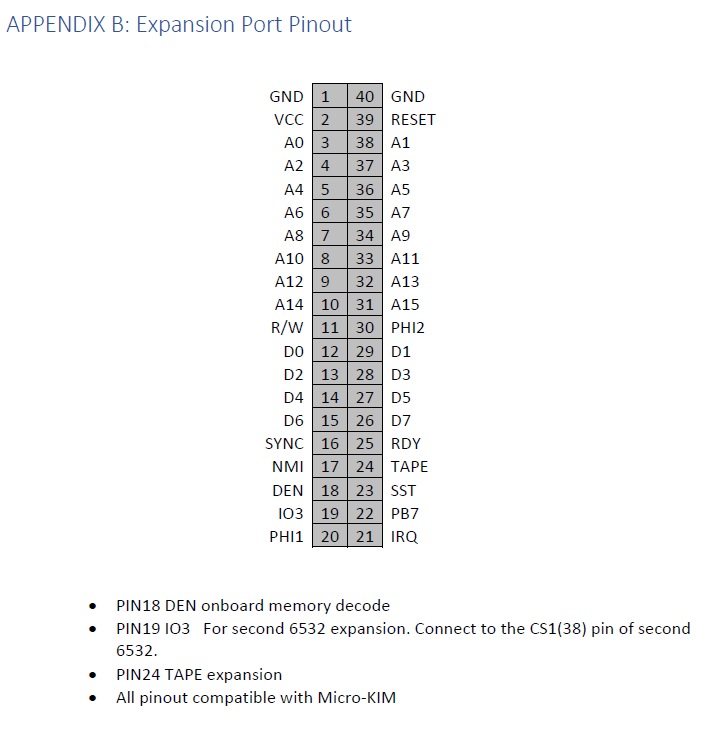
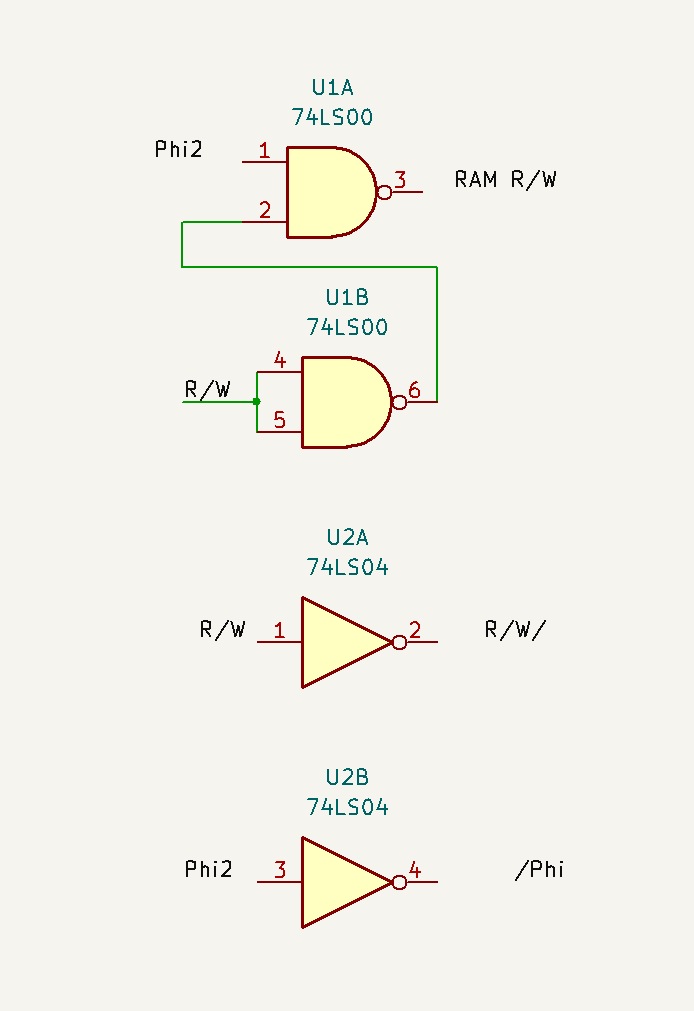
The circuit on the PAL-1 Motherboard Expansion
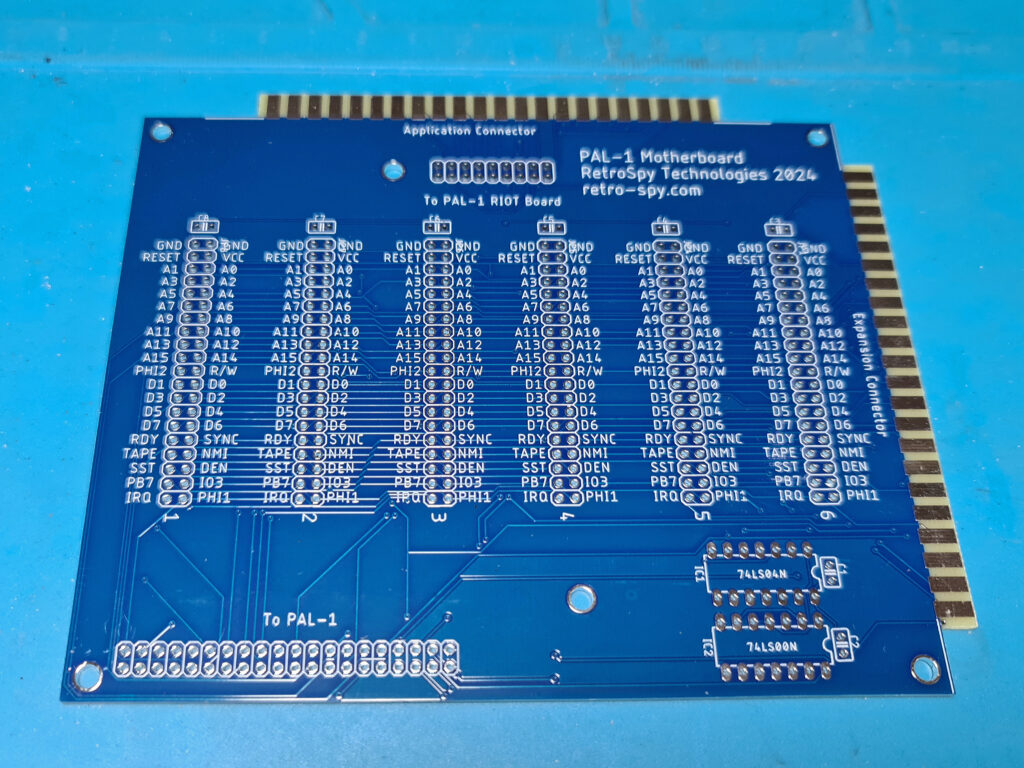
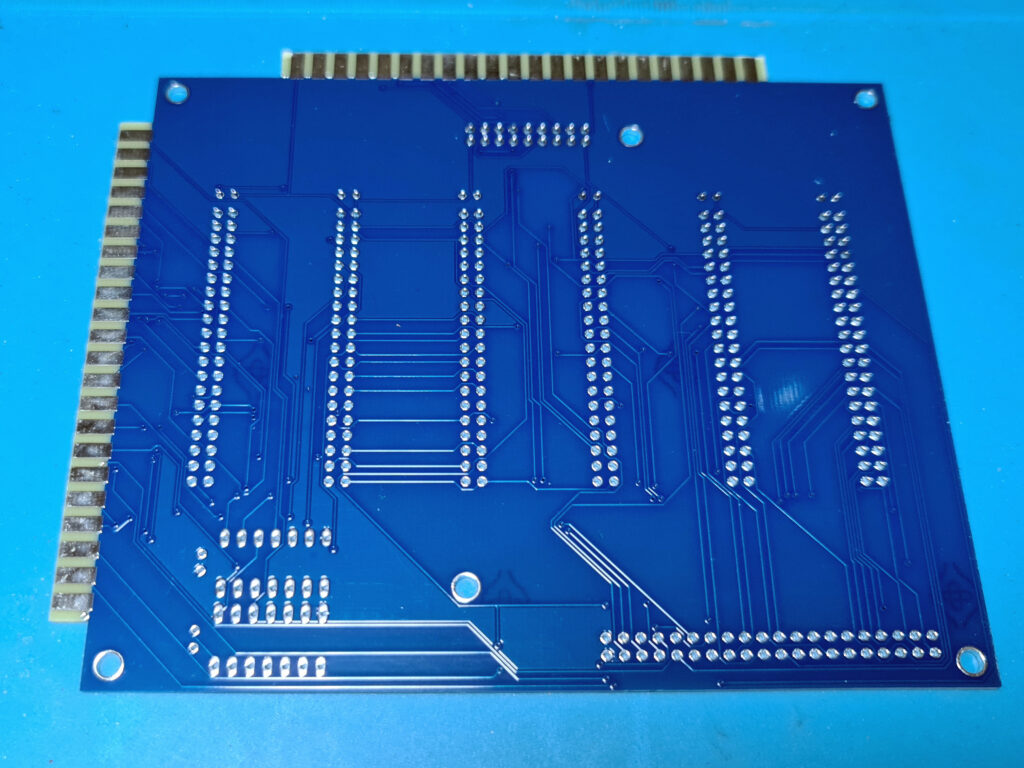
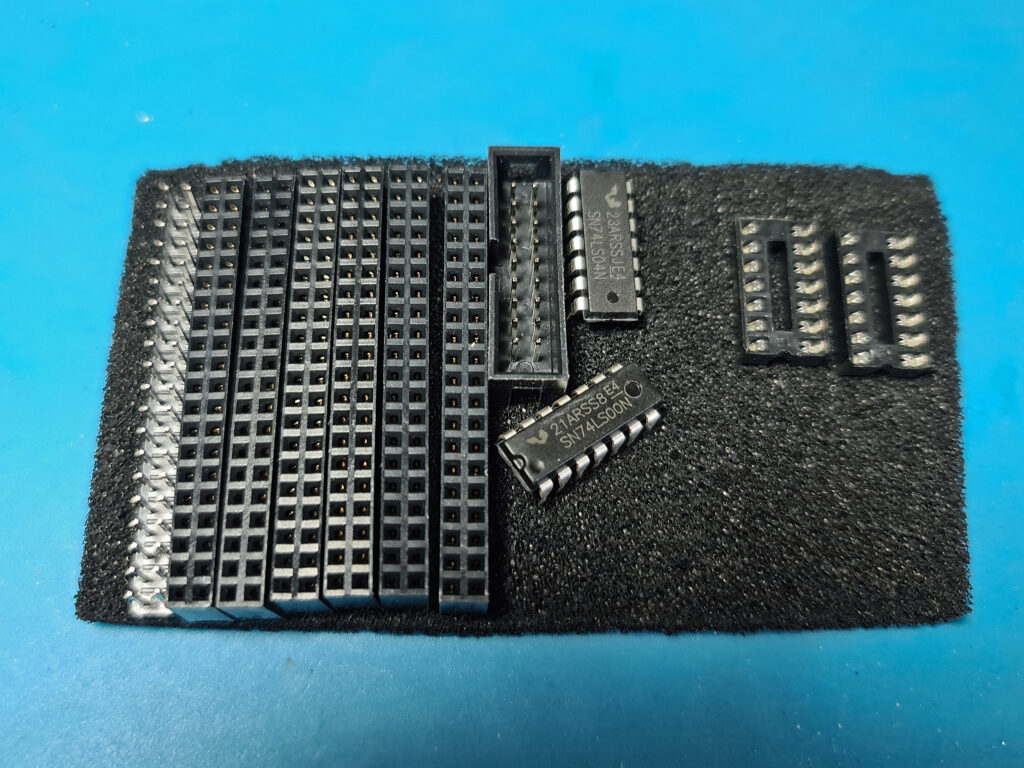
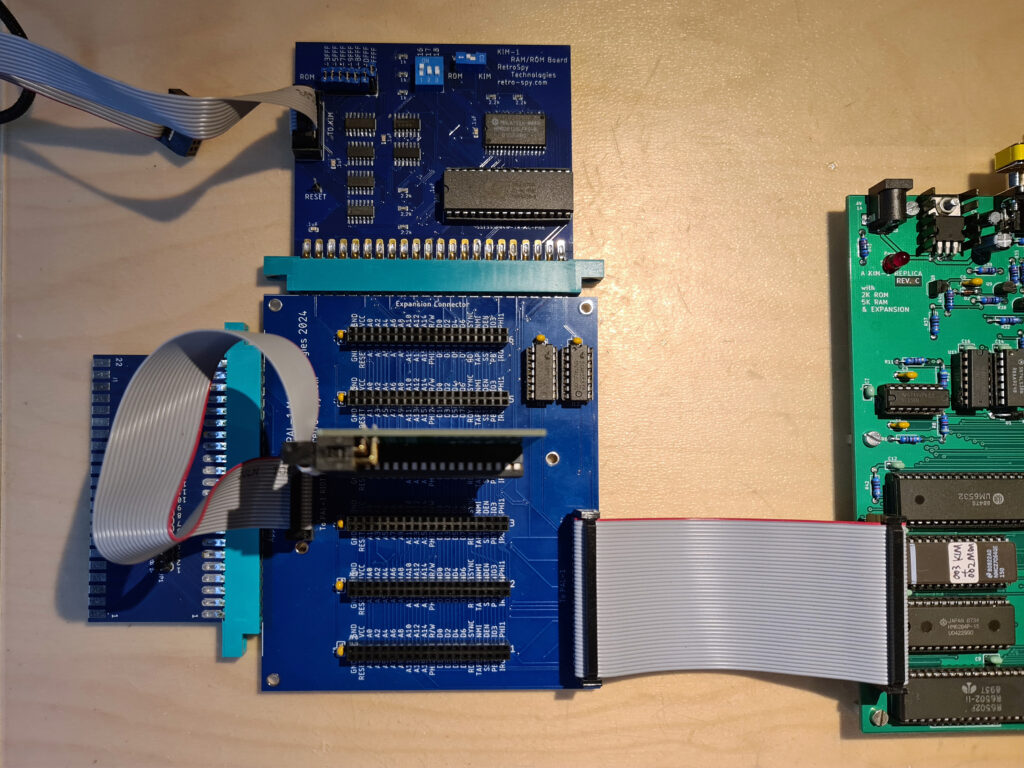
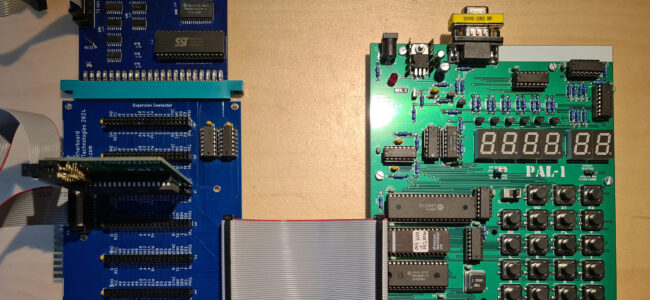
 RetroSpy Technologies produces a range of retro (Vintage) hardware products that are of interest for the KIM-1/SYM-1/AIM 65 owner. Also the PAL-1 user may benefit from the products!
RetroSpy Technologies produces a range of retro (Vintage) hardware products that are of interest for the KIM-1/SYM-1/AIM 65 owner. Also the PAL-1 user may benefit from the products!
Retrospy is inspired by the Corsham Technologies products and since Bob Applegate is no more among us, produces similar/inspired products.
I bought several products from RetroSpy.
Other interesting KIM-1/AIM 65/SYM- related boards on the Retrospy shop:
AIM 65 I/O board
SYM-1 I/O board
SYM-1 SymDos I/O board
SYM-1/AIM-65 RAM/ROM board
KIM-1 I/O board
2532 to 2764 EPROM adapter
SD Card Storage System (like the Corsham one)
I should have bought he KIM I/O card also, for the 1541 connector, next time!

KIM-1 keypad replacement
